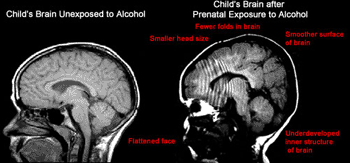MR Images Show How Fetal Alcohol Exposure Affects Children’s
By MedImaging International staff writers
Posted on 08 Jan 2013
Children exposed to alcohol during fetal development show brain structure and metabolism alterations that can be seen using various imaging techniques.Posted on 08 Jan 2013
The study’s findings were presented November 25, 2012, at the annual meeting of the Radiological Society of North America (RSNA), held in Chicago (IL, USA). Alcohol use by expectant mothers can lead to problems with the mental and physical development of their children—a disorder known as fetal alcohol syndrome. Research suggests an incidence of 0.2 to 1.5 per 1,000 live births, according to the US Centers for Disease Control and Prevention (Atlanta, GA, USA). Costs for care of individuals affected by fetal alcohol syndrome in the United States have been estimated at USD 4 billion yearly.

Image: MR comparison showing the brains of two children and the effects of alcohol exposure during pregnancy (Photo courtesy of the Children’s Research Triangle).
Developments in magnetic resonance imaging (MRI) technology are providing extraordinary clues into the effects of alcohol on the central nervous systems (CNS) of children whose mothers drank alcohol during their pregnancy. Recently, Polish researchers used three different MRI techniques to better define these effects.
The study group consisted of 200 children who were exposed to alcohol during their fetal stage and 30 children whose mothers did not drink while pregnant or during lactation. Researchers used MRI to evaluate the size and shape of the corpus callosum, the bundle of nerve fibers that forms the major communication link between the right and left halves of the brain, in the two groups. Prenatal alcohol exposure is the major cause of impaired development or complete absence of the corpus callosum.
The MRI scan findings showed statistically significant thinning of the corpus callosum in the children exposed to alcohol compared with the other group. “These changes are strongly associated with psychological problems in children,” said Andrzej Urbanik, MD, chair of the department of radiology at Jagiellonian University (Krakow, Poland).
Dr. Urbanik and colleagues also employed diffusion-weighted imaging (DWI) to study six areas of the central nervous system in the children. DWI maps the diffusion process of water and can be a more sensitive means than traditional MRI for detecting tissue abnormalities. Children in the alcohol group exhibited statistically considerable increases in diffusion on DWI compared with the other children. “The increase of diffusion indicates neurological disorders or damage to the brain tissue,” Dr. Urbanik said.
To noninvasively assess metabolism in the children’s brains, the researchers used proton (hydrogen) magnetic resonance spectroscopy (HMRS), a typical addition to structural MRI scans. HMRS findings revealed a complex collection of metabolic changes. “In individual cases, we found a high degree of metabolic changes that were specific for particular locations within the brain,” Dr. Urbanik said.
Related Links:
Jagiellonian University














